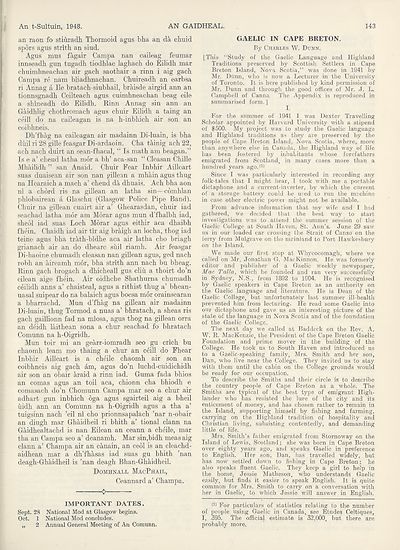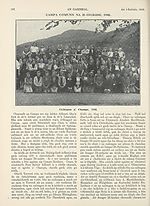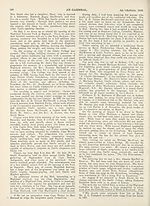An Comunn Gàidhealach Publications > Gaidheal > Volume 43, October 1947--December 1948
(151) Page 143
Download files
Complete book:
Individual page:
Thumbnail gallery: Grid view | List view

An t-Sultuinj 1948.
AN GAIDHEAL.
143
an raon fo stiuradh Thormoid agus bha an da chuid
spdrs agus strlth an siud.
Agus mus fagair Campa nan caileag feumar
innseadh gun tugadh tiodhlac laghach do Eilidh mar
chuimhneachan air gach saothair a rinn i aig gach
Campa re nam bliadhnachan. Chuireadh an earbsa
ri Annag a He bratach-siubhail, braisde airgid ann an
tionnsgnadh Ceilteach agus cuimhneachan beag eile
a shineadh do Eilidh. Rinn Annag sin ann an
Gaidhlig chothromach agus chuir Eilidh a taing an
ceill do na caileagan is na h-inbhich air son an
coibhneis.
Dh’fhag na caileagan air madainn Di-luain, is bha
duil ri 28 gille feasgar Di-ardaoin. Cha tainig ach 22,
ach nach duirt an sean-fhacal, “ Is math am beagan.”
Is e a’ cheud latha mor a bh’ aca-san “ Cleasan Chille
Mhailidh ” san Anaid. Chuir Fear Inbhir Ailleart
suas duaisean air son nan gillean a mhain agus thug
na Hearaich a mach a’ cheud da dhuais. Ach bha aon
nl a chord ris na gillean an latha sin—comhlan
phiobairean a Glaschu (Glasgow Police Pipe Band).
Chuir na gillean cuairt air a’ Ghearasdan, chuir iad
seachad latha mor am Morar agus mun d’fhalbh iad,
sheol iad suas Loch Morar agus eithir aca dhaibh
fhein. Chaidh iad air tir aig braigh an locha, thog iad
teine agus bha trath-bidhe aca air latha cho briagh
grianach air an do dhearc suil riamh. Air feasgar
Di-haoine chumadh cleasan nan gillean agus, ged nach
robh an aireamh mor, bha strlth ann nach bu bheag.
Rinn gach brogach a dhicheall gus cliu a thoirt do’n
eilean aige fhein. Air oidhche Shathurna chumadh
ceilidh anns a’ chaisteal, agus a rithist thug a’ bhean-
uasal suipear do na balaich agus bocsa mor orainsearan
a bharrachd. Mun d’fhag na gillean air madainn
Di-luain, thug Tormod a nuas a’ bhratach, a sheas ris
gach gaillionn fad na mlosa, agus thog na gillean orra
an deidh laithean sona a chur seachad fo bhratach
Comunn na h-Oigridh.
Mun toir mi an gearr-iomradh seo gu crich bu
chaomh leam mo thaing a chur an ceill do Fhear
Inbhir Ailleart is a cheile chaomh air son an
coibhneis aig gach am, agus do’n luchd-cuidichidh
air son an obair araid a rinn iad. Guma fada bhios
an comas agus an toil aca, chionn cha bhiodh e
comasach do’n Chomunn Campa mar seo a chur air
adhart gun inbhich oga agus sgairteil aig a bheil
uidh ann an Comunn na h-Oigridh agus a tha a’
tuigsinn nach ’eil ni cho prionnsapalach ’nar n-obair
an diugh mar Ghaidheil ri bhith a’ tional clann na
Gaidhealtachd is nan Eilean an ceann a cheile, mar
tha an Campa seo a’ deanamh. Mar sin,bidh meas aig
clann a’ Champa air an canain, an cedi is an cleachd-
aidhean mar a dh’fhasas iad suas gu bhith ’nan
deagh-Ghaidheil is ’nan deagh Bhan-Ghaidheil.
Domhnall MacPhail,
Ceannard a’ Champa.
<>
IMPORTANT DATES.
Sept. 28 National Mod at Glasgow begins.
Oct. 1 National Mod concludes.
„ 2 Annual General Meeting of An Comunn.
GAELIC IN CAPE BRETON.
By Charles W. Dunn.
[This “Study of the Gaelic Language and Highland
Traditions preserved by Scottish Settlers in Cape
Breton Island, Nova Scotia,” was done in 1941 by
Mr. Dunn, who is now a Lecturer in the University
of Toronto. It is here published by kind permission of
Mr. Dunn and through the good offices of Mr. J. L.
Campbell of Canna The Appendix is reproduced in
summarised form.]
For the summer of 1941 I was Dexter Travelling
Scholar appointed by Harvard University with a stipend
of $500. My project was to study the Gaelic language
and Highland traditions as they are preserved by the
people of Cape Breton Island, Nova Scotia, where, more
than anywhere else in Canada, the Highland way of life
has been fostered by inhabitants whose forefathers
emigrated from Scotland, in many cases more than a
hundred years ago. I1)
Since I was particularly interested in recording any
folk-tales that I might hear, I took with me a portable
dictaphone and a current-inverter, by which the current
of a storage battery could be used to run the machine
in case other electric power might not be available.
From advance information that my wife and I had
gathered, we decided that the best way to start
investigations was to attend the summer session of the
Gaelic College at South Haven, St. Ann’s. June 29 saw
us in our loaded car crossing the Strait of Canso on the
ferry from Mulgrave on the mainland to Port Hawkesbury
on the Island.
We made our first stop at Whycocomagh, where we
called on Mr. Jonathan G. MacKinnon. He was formerly
editor and publisher of a Gaelic weekly newspaper,
Mac Talla, which he founded and ran very successfully
in Sydney, N.S., from 1892 to 1604. He is recognised
by Gaelic speakers in Cape Breton as an authority on
the Gaelic language and literature. He is Dean of the
Gaelic College, but unfortunately last summer ill-health
prevented him from lecturing. He read some Gaelic into
our dictaphone and gave us an interesting picture of the
state of the language in Nova Scotia and of the foundation
of the Gaelic College.
The next day we called at Baddeck on the Rev. A.
W. R. MacKenzie, the President of the Cape Breton Gaelic
Foundation and prime mover in the building of the
College. He took us to South Haven and introduced us
to a Gaelic-speaking family, Mrs. Smith and her son,
Dan, who live near the College. They invited us to stay
with them until the cabin on the College grounds would
be ready for our occupation.
To describe the Smiths and their circle is to describe
the country people of Cape Breton as a whole. The
Smiths are typical of the best type of emigrant' High¬
lander who has resisted the lure of the city and its
enticement of money, and has chosen rather to remain in
the Island, supporting himself by fishing and farming,
carrying on the Highland tradition of hospitality and
Christian living, subsisting contentedly, and demanding
little of life.
Mrs. Smith’s father emigrated from Stornoway on the
Island of Lewis, Scotland; she was born in Cape Breton
over eighty years ago, and speaks Gaelic in preference
to English. Her son, Dan, has travelled widely, but
has now settled down to fishing in Cape Breton; he
also speaks fluent Gaelic. They keep a girl to help in
the home, Jessie Matheson, who understands Gaelic
easily, but finds it easier to speak English. It is quite
common for Mrs. Smith to carry on a conversation with
her in Gaelic, to which Jessie will answer in English.
W For particulars of statistics relating to the number
qf people using Gaelic in Canada, see Etudes Celtiques,
I, 395. The official estimate is 32,000, but there are
probably more.
AN GAIDHEAL.
143
an raon fo stiuradh Thormoid agus bha an da chuid
spdrs agus strlth an siud.
Agus mus fagair Campa nan caileag feumar
innseadh gun tugadh tiodhlac laghach do Eilidh mar
chuimhneachan air gach saothair a rinn i aig gach
Campa re nam bliadhnachan. Chuireadh an earbsa
ri Annag a He bratach-siubhail, braisde airgid ann an
tionnsgnadh Ceilteach agus cuimhneachan beag eile
a shineadh do Eilidh. Rinn Annag sin ann an
Gaidhlig chothromach agus chuir Eilidh a taing an
ceill do na caileagan is na h-inbhich air son an
coibhneis.
Dh’fhag na caileagan air madainn Di-luain, is bha
duil ri 28 gille feasgar Di-ardaoin. Cha tainig ach 22,
ach nach duirt an sean-fhacal, “ Is math am beagan.”
Is e a’ cheud latha mor a bh’ aca-san “ Cleasan Chille
Mhailidh ” san Anaid. Chuir Fear Inbhir Ailleart
suas duaisean air son nan gillean a mhain agus thug
na Hearaich a mach a’ cheud da dhuais. Ach bha aon
nl a chord ris na gillean an latha sin—comhlan
phiobairean a Glaschu (Glasgow Police Pipe Band).
Chuir na gillean cuairt air a’ Ghearasdan, chuir iad
seachad latha mor am Morar agus mun d’fhalbh iad,
sheol iad suas Loch Morar agus eithir aca dhaibh
fhein. Chaidh iad air tir aig braigh an locha, thog iad
teine agus bha trath-bidhe aca air latha cho briagh
grianach air an do dhearc suil riamh. Air feasgar
Di-haoine chumadh cleasan nan gillean agus, ged nach
robh an aireamh mor, bha strlth ann nach bu bheag.
Rinn gach brogach a dhicheall gus cliu a thoirt do’n
eilean aige fhein. Air oidhche Shathurna chumadh
ceilidh anns a’ chaisteal, agus a rithist thug a’ bhean-
uasal suipear do na balaich agus bocsa mor orainsearan
a bharrachd. Mun d’fhag na gillean air madainn
Di-luain, thug Tormod a nuas a’ bhratach, a sheas ris
gach gaillionn fad na mlosa, agus thog na gillean orra
an deidh laithean sona a chur seachad fo bhratach
Comunn na h-Oigridh.
Mun toir mi an gearr-iomradh seo gu crich bu
chaomh leam mo thaing a chur an ceill do Fhear
Inbhir Ailleart is a cheile chaomh air son an
coibhneis aig gach am, agus do’n luchd-cuidichidh
air son an obair araid a rinn iad. Guma fada bhios
an comas agus an toil aca, chionn cha bhiodh e
comasach do’n Chomunn Campa mar seo a chur air
adhart gun inbhich oga agus sgairteil aig a bheil
uidh ann an Comunn na h-Oigridh agus a tha a’
tuigsinn nach ’eil ni cho prionnsapalach ’nar n-obair
an diugh mar Ghaidheil ri bhith a’ tional clann na
Gaidhealtachd is nan Eilean an ceann a cheile, mar
tha an Campa seo a’ deanamh. Mar sin,bidh meas aig
clann a’ Champa air an canain, an cedi is an cleachd-
aidhean mar a dh’fhasas iad suas gu bhith ’nan
deagh-Ghaidheil is ’nan deagh Bhan-Ghaidheil.
Domhnall MacPhail,
Ceannard a’ Champa.
<>
IMPORTANT DATES.
Sept. 28 National Mod at Glasgow begins.
Oct. 1 National Mod concludes.
„ 2 Annual General Meeting of An Comunn.
GAELIC IN CAPE BRETON.
By Charles W. Dunn.
[This “Study of the Gaelic Language and Highland
Traditions preserved by Scottish Settlers in Cape
Breton Island, Nova Scotia,” was done in 1941 by
Mr. Dunn, who is now a Lecturer in the University
of Toronto. It is here published by kind permission of
Mr. Dunn and through the good offices of Mr. J. L.
Campbell of Canna The Appendix is reproduced in
summarised form.]
For the summer of 1941 I was Dexter Travelling
Scholar appointed by Harvard University with a stipend
of $500. My project was to study the Gaelic language
and Highland traditions as they are preserved by the
people of Cape Breton Island, Nova Scotia, where, more
than anywhere else in Canada, the Highland way of life
has been fostered by inhabitants whose forefathers
emigrated from Scotland, in many cases more than a
hundred years ago. I1)
Since I was particularly interested in recording any
folk-tales that I might hear, I took with me a portable
dictaphone and a current-inverter, by which the current
of a storage battery could be used to run the machine
in case other electric power might not be available.
From advance information that my wife and I had
gathered, we decided that the best way to start
investigations was to attend the summer session of the
Gaelic College at South Haven, St. Ann’s. June 29 saw
us in our loaded car crossing the Strait of Canso on the
ferry from Mulgrave on the mainland to Port Hawkesbury
on the Island.
We made our first stop at Whycocomagh, where we
called on Mr. Jonathan G. MacKinnon. He was formerly
editor and publisher of a Gaelic weekly newspaper,
Mac Talla, which he founded and ran very successfully
in Sydney, N.S., from 1892 to 1604. He is recognised
by Gaelic speakers in Cape Breton as an authority on
the Gaelic language and literature. He is Dean of the
Gaelic College, but unfortunately last summer ill-health
prevented him from lecturing. He read some Gaelic into
our dictaphone and gave us an interesting picture of the
state of the language in Nova Scotia and of the foundation
of the Gaelic College.
The next day we called at Baddeck on the Rev. A.
W. R. MacKenzie, the President of the Cape Breton Gaelic
Foundation and prime mover in the building of the
College. He took us to South Haven and introduced us
to a Gaelic-speaking family, Mrs. Smith and her son,
Dan, who live near the College. They invited us to stay
with them until the cabin on the College grounds would
be ready for our occupation.
To describe the Smiths and their circle is to describe
the country people of Cape Breton as a whole. The
Smiths are typical of the best type of emigrant' High¬
lander who has resisted the lure of the city and its
enticement of money, and has chosen rather to remain in
the Island, supporting himself by fishing and farming,
carrying on the Highland tradition of hospitality and
Christian living, subsisting contentedly, and demanding
little of life.
Mrs. Smith’s father emigrated from Stornoway on the
Island of Lewis, Scotland; she was born in Cape Breton
over eighty years ago, and speaks Gaelic in preference
to English. Her son, Dan, has travelled widely, but
has now settled down to fishing in Cape Breton; he
also speaks fluent Gaelic. They keep a girl to help in
the home, Jessie Matheson, who understands Gaelic
easily, but finds it easier to speak English. It is quite
common for Mrs. Smith to carry on a conversation with
her in Gaelic, to which Jessie will answer in English.
W For particulars of statistics relating to the number
qf people using Gaelic in Canada, see Etudes Celtiques,
I, 395. The official estimate is 32,000, but there are
probably more.
Set display mode to:
![]() Universal Viewer |
Universal Viewer | ![]() Mirador |
Large image | Transcription
Mirador |
Large image | Transcription
| An Comunn Gàidhealach > An Comunn Gàidhealach Publications > Gaidheal > Volume 43, October 1947--December 1948 > (151) Page 143 |
|---|
| Permanent URL | https://digital.nls.uk/125253084 |
|---|
| Description | This contains items published by An Comunn, which are not specifically Mòd-related. It includes journals, annual reports and corporate documents, policy statements, educational resources and published plays and literature. It is arranged alphabetically by title. |
|---|
| Description | A collection of over 400 items published by An Comunn Gàidhealach, the organisation which promotes Gaelic language and culture and organises the Royal National Mòd. Dating from 1891 up to the present day, the collection includes journals and newspapers, annual reports, educational materials, national Mòd programmes, published Mòd literature and music. |
|---|---|
| Additional NLS resources: |
|

